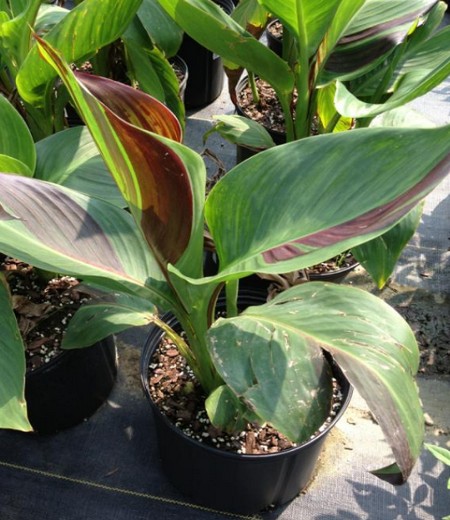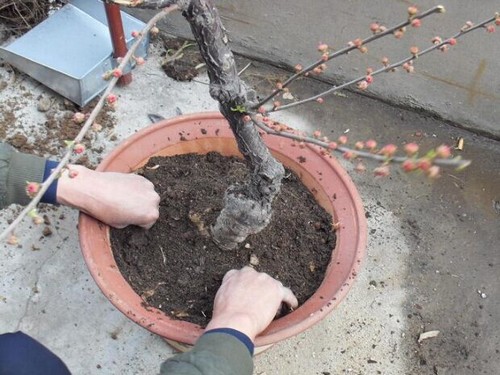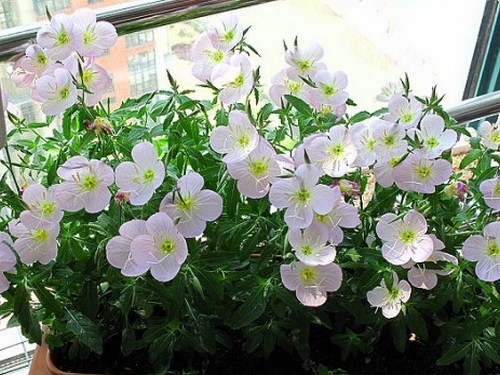Planting method of potted canna
Banana is strong, adaptable, likes sunny, warm and even hot environmental conditions, but also more cold-resistant, lax requirements on the soil, can grow in all kinds of soil, but the soil layer is deep and fertile soil grows well. The suitable temperature for growth is higher than that of ordinary flowers, which is 2530 degrees Celsius. Below, the editor of Qiannong Network will introduce to you the cultivation methods of banana pot cultivation.

The main results are as follows: 1. Dwarf varieties should be selected for potted canna. Generally, the proportion of rotten leaf soil, vegetable garden soil and rice chaff ash is 1 ∶ 1.5 ∶ 0.5, and a small amount of bean cake, bone meal and other fertilizers are added. From March to April in spring, take out the tuber, remove the rotten part, select the stem with two or three strong buds and bury it in the basin soil, and the bud tip is best exposed.
Because canna is very fond of fertilizer and moisture resistance, the basin should be watered thoroughly. When the fifth leaf grows to the fifth leaf, mature topdressing should be applied every 7-10 days, and water should be applied after fertilization. Generally, 1% ferrous sulfate fertilizer and water is applied once a month, or a small amount of plant ash is added to make the stem straight and strong, the leaves green and thick, and the flowers bright. Stop fertilizing at the flowering stage. If you put it in a cooler place during flowering, you can prolong the flowering period. When the flower at the tip of the stem lags behind, the stem branches should be cut off from the base at any time in order to sprout new buds.
2. When potted canna is planted, the budding treatment in greenhouse can bloom earlier. During the operation, the old root should be covered with wet sand or loose peat soil from February to March, so that the rhizome should be covered properly and germinated at 16 degrees Celsius. When the buds on the rhizome germinate, cut the old stem into several pieces, each with more than one bud, planted in a flowerpot with a diameter of 10 cm and 12 cm, and change the pot again in April. According to the actual situation, a pot of 15 cm diameter can be used. It was moved to outdoor maintenance in the middle of May or planted in the open field, and it could blossom from July to August.
3. Potted canna sometimes has scorched and yellowed leaves, mainly due to excessive application of ferrous sulfate or exposure to drought and hot sun. In the hot summer, if poured too cold water will also cause the leaf edge scorch, such as in the heat of summer fertilization is too thick, there will be cauterization of the rhizome to "burn". Therefore, when the temperature is as high as 40 degrees Celsius, the canna can be moved to a cool and ventilated place. Before and after Frosts Descent, the potted canna can be moved to a temperature of 5-10 degrees Celsius to survive the winter safely, and fertilization will be stopped during the overwintering period.
4. Potted canna should pay attention to leaf curling pests from May to August every year, so as not to damage its tender leaves and inflorescences. It can be sprayed with 1000 times of 50% dichlorvos or 50% EC of dichlorvos. There are occasional tigers in canna, which can be caught manually or poured into the root soil with 600 ~ 800 times solution of trichlorfon.
[planting method of canna]
1. Sow and reproduce.
The hard seed coat of the seed was cut with a sharp tool from April to May, soaked in warm water for one day and night, then sowed in open ground, sprouted 2-3 weeks after sowing, transplanted once when 2-3 leaves grew, and could blossom in the same year or the following year. It is a common material for shrub edge, flower diameter and flower mirror in gardens.
It is suitable to choose dwarf varieties in potted plants. The basin soil is mixed with loam rich in organic matter and a small amount of river sand. Planting after late frost in spring, 1-2 plants per pot, watering enough water after planting, and keeping the pot soil moist, otherwise it will lead to scorched leaf edges and even sparse flowering. After the plant grew to 3-4 leaves, liquid fertilizer was applied every 10 days. Until it blossoms. Cut off the residual flowers in time after flowering to promote them to sprout new branches. Move to indoor maintenance to survive the winter before autumn frost.
2. Propagate with tubers.
Tuber propagation takes place from March to April. The old rhizome was dug out and divided into blocks. 2-3 buds were retained on each rhizome with roots, which were planted in soil with about 10cm depth, plant spacing was kept 40~50cm, and enough water was poured. When a new bud grows to 5 or 6 leaves, a rotten fertilizer should be applied so that it can blossom in the same year.
Planting: in the early and middle of April (Zhengzhou area). The root stem of each hole was planted with 2-3 buds, the distance from the hole to 80cm, the depth of the hole was about 20cm, and the soil thickness was about 10cm after planting.
When potted, choose low varieties and leave 3 buds in each pot. After planting, the soil covered with 8~10cm is thick.
Light and temperature: sufficient light is required during the growing period, and be sure to receive at least 5 hours of direct sunlight every day. The environment is too dark, lack of light, will delay the flowering period, like warmth, avoid severe cold, suitable for a long temperature of 16-30 ℃. When flowering, in order to prolong the flowering period, it can be placed in a place with low temperature and no sunlight, and the ambient temperature should not be lower than 10 ℃.
Watering and fertilization: after planting, the rhizome should be watered less before it grows new roots. The basin soil should be moist. The soil is too wet and rots easily. After the scape grows, it should be often watered to keep the basin soil moist. If there is a lack of water, it is easy to appear the phenomenon of "flowers in the leaves" after flowering. Watering should be reduced in winter, based on the principle of "dry and wet". In addition to applying sufficient base fertilizer before planting, thin cake liquid fertilizer should be applied 3 or 4 times a month in the peak growing season. If the scape is not produced 20-30 days before the scheduled flowering period, 0.2% potassium dihydrogen phosphate aqueous solution can be sprayed once to promote the flowering.
Florescence control: if you want to blossom on May Day, cover the stored rhizome with soil mixed with a small amount of fertilizer in January and require the ambient temperature to be 30 ℃ during the day and 15 ℃ at night. After 10 days, it can sprout. After sprouting, plant the rhizome with 2 or 3 buds into the basin to keep the basin soil moist and fertilize appropriately. There are buds in early April, pay attention to ventilation, "May Day" can blossom.
Rhizome excavation: in the cold area, after frosting twice and most of the stems and leaves are withered and yellow in autumn, cut off the aboveground part, dig out the rhizome, properly dry and pile it indoors, which can safely survive the winter under the temperature of 5: 7 ℃. The warm land can live in the open field in winter without harvest, but it must be dug up and replanted after 2-3 years, and the planting scale can be expanded at the same time.
Time: 2019-05-25 Click:
- Prev

Planting method of Prunus mume
One of the main flowering shrubs in the north, having lush leaves and colorful petals. Planted in front of the courtyard and on the side of the road, it can also be used as potted plants and cut flowers. In the cultivation and management, attention should be paid to pruning and fertilization after anthesis to ensure that there are enough flower branches in the coming year. 1. Site selection: Prunus mandshurica is strong, like sunshine, resistant to drought and cold.
- Next

Planting methods of Evening Primrose
Evening primrose has strong adaptability, acid and drought resistance, loose soil requirements, generally neutral, slightly alkaline or slightly acidic soil, good drainage, loose soil can grow, it is easy to get disease in the wet soil. North America is an annual plant. It is the most important nutritional drug discovered in this century. Can treat a variety of diseases
Related
- Fuxing push coffee new agricultural production and marketing class: lack of small-scale processing plants
- Jujube rice field leisure farm deep ploughing Yilan for five years to create a space for organic food and play
- Nongyu Farm-A trial of organic papaya for brave women with advanced technology
- Four points for attention in the prevention and control of diseases and insect pests of edible fungi
- How to add nutrient solution to Edible Fungi
- Is there any good way to control edible fungus mites?
- Open Inoculation Technology of Edible Fungi
- Is there any clever way to use fertilizer for edible fungus in winter?
- What agents are used to kill the pathogens of edible fungi in the mushroom shed?
- Rapid drying of Edible Fungi

